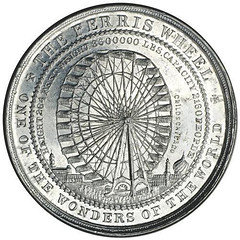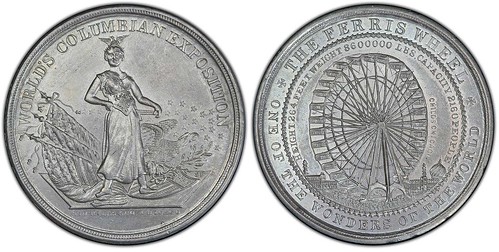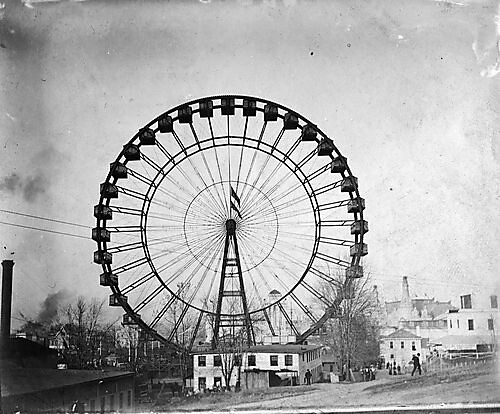
PREV ARTICLE
NEXT ARTICLE
FULL ISSUE
PREV FULL ISSUE
V25 2022 INDEX E-SYLUM ARCHIVE FERRIS WHEEL MEDALSAn article by Jay Turner published on the PCGS website illustrates some so-called dollars picturing the Ferris Wheel from the 1893 World's Columbian Exposition in Chicago. Designed by Pittsburgh bridge-builder George W. Ferris, the rides remain a staple of amusement parks worldwide. The 1893 World's Fair wheel and an earlier prototype built in Pittsburgh were demolished long ago. I've added an image of the early model from the Historic Pittsburgh website. Here's an excerpt from Jay's article - see the complete article online. -Editor
The United States needed its own Eiffel Tower, something that would stun, amaze, and would be talked about for years. The proposals ran from the ridiculous to the impossible. One such proposal was a tower made from stacked logs that would measure 2,000 feet with a replica of Abraham Lincoln's boyhood home at the top. Another absurd proposal called for a structure to be built so tall that visitors would ride an elevator to the top in Chicago and take a slide down allowing them to arrive in San Francisco or New York. An American civil engineer, George Washington Gale Ferris, Jr., stepped forward with plans that would Ferris had come to Chicago in 1891 with the news of the World's Columbian Exposition to be held there in 1893. His proposed design for the exposition was a wheel that would rotate, allowing visitors to view the entire exhibition. The idea of a rotating wheel ride wasn't unique. Concepts had existed since the 1600s, a rotating wheel was created for the 1854 New York State Fair, and in 1892 three 50-foot wooden wheels were installed in amusement parks in New York and New Jersey. Yet Ferris' design called for a wheel of a size and design that was so unique that when proposed it was deemed unsafe. When Ferris returned a few weeks later with respectable endorsements from established engineers and local investors who were willing to cover the $400,000 construction costs, the plans were approved. When construction was done on Ferris's wheel, the structure had a height of 264 feet, the tallest attraction at the World's Columbian Exposition. While it was shorter than Eiffel's tower (1,063 feet), his structure didn't move. The wheel had 36 passenger cars, each car had 40 revolving chairs and could hold 60 individuals, giving the attraction a total capacity of 2,160 people at any given time. On June 9, 1893, the wheel was given its first test run and when it started bolts and debris fell from the sky, but it worked.
The World's Columbian Exposition offered countless souvenirs and collectibles for visitors. The Ferris wheel was a popular highlight of the World's Fair and, after having the experience of seeing and riding the attraction, it was something people wanted a keepsake of. Several medals were made featuring the Ferris wheel at the Columbian Exposition, including four medals that would be later cataloged as So-Called Dollars. HK-170 features the Ferris wheel on the reverse with the inscription
To read the complete articles, see:
Wayne Homren, Editor The Numismatic Bibliomania Society is a non-profit organization promoting numismatic literature. See our web site at coinbooks.org. To submit items for publication in The E-Sylum, write to the Editor at this address: whomren@gmail.com To subscribe go to: https://my.binhost.com/lists/listinfo/esylum All Rights Reserved. NBS Home Page Contact the NBS webmaster 
|



